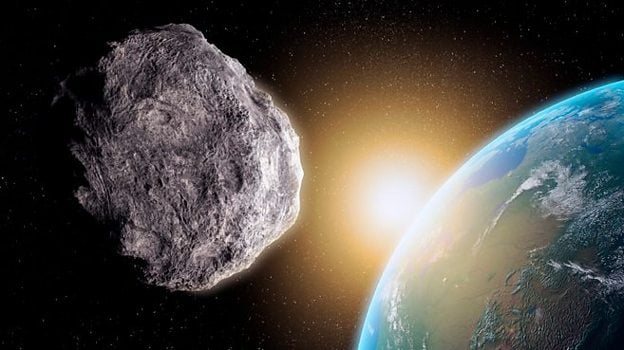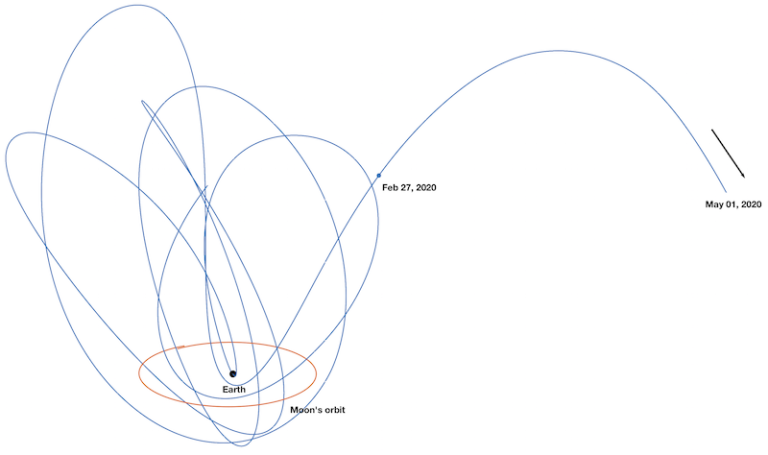How the Moon Constantly Creates New Minimoons
Earth’s gravity occasionally captures tiny natural objects—called minimoons—that originate not only from the asteroid belt but also from lunar impact debris. Recent research shows that a significant fraction of these transient satellites are likely ejected fragments from the Moon, offering unique low-delta-v opportunities for scientific study and resource utilization.
Summary
- Definition of Minimoons: Tiny natural satellites temporarily bound to Earth, completing at least one orbit before escaping.
- Known Examples: Only four confirmed minimoons to date: 2006 RH₁₂₀, 2020 CD₃, 2024 PT₅, 2022 NX₁.
- Origins: Two main source regions—main asteroid belt and lunar ejecta—with spectral evidence favoring lunar basalt for some objects.
- Capture Mechanisms: “Prompt bounding” immediately after ejection vs. “delayed bounding” after heliocentric orbit.
- Population Estimates: Steady-state models predict ~1 object of 1–2 m diameter at any time, with hundreds of smaller fragments in transient orbits.
- Orbital Characteristics: Geocentric distances within three Earth Hill radii; negative total geocentric energy when bound.
- Spectral Signatures: Lunar-origin minimoons match basaltic lunar samples; asteroid-origin show chondritic spectra.
- Lifetimes: Ranging from days to months; average lifetimes depend on ejection speed and orbital dynamics.
- Scientific Opportunities: In-situ study of lunar material without sample-return missions; testing models of crater formation.
- Technology Prospects: Low Δv missions to minimoons for resource extraction and technology demonstration.
- Detection Challenges: Small sizes, rapid sky motion, faint magnitudes require advanced surveys (e.g., LSST).
- Future Surveys: Rubin Observatory expected to increase detections, refining population models.
- Crater-Scaling Uncertainties: Large error bars in ejecta mass-velocity relations affect population predictions.
- Resource Potential: Water and minerals in ejecta could support cislunar infrastructure.
- Dynamic Earth–Moon Exchange: Continuous material exchange reshapes our understanding of near-Earth space.

Introduction
Earth’s only permanent natural satellite, the Moon, orbits at an average distance of ~384,400 km and formed about 4.5 billion years ago from a giant impact event. Yet, our planet temporarily hosts other tiny satellites—minimoons—that hitch a brief ride in Earth’s gravity well before returning to solar orbit.
What Are Minimoons?
Minimoons, or temporarily captured orbiters (TCOs), are small (centimeter to meter scale) natural objects that become gravitationally bound to Earth, completing at least one orbit in a rotating geocentric frame before escaping back to heliocentric trajectories. Granvik et al. (2012) first modeled a steady-state population of these objects, predicting about one 1–2 m diameter minimoon at any time, with numbers increasing for smaller sizes.
Known Minimoons
| Object | Diameter (m) | Capture Period | Origin Spectra | Reference |
|---|---|---|---|---|
| 2006 RH₁₂₀ | ~2 | Sep 2006 – Jun 2007 | Chondritic (asteroid) | Granvik et al. 2012 ScienceDirect |
| 2020 CD₃ | ~1.2 | Feb 2020 – May 2020 | Lunar basalt | Jedicke et al. 2025 arXiv |
| 2024 PT₅ | ~0.8 | Aug 2024 – Nov 2024 | Lunar basalt | Jedicke et al. 2025 arXiv |
| 2022 NX₁ | ~0.5 | Jul 2022 – Sep 2022 | Lunar basalt | Jedicke et al. 2025 arXiv |
Origins and Capture Mechanisms
Minimoons arise from two primary reservoirs:
| Source Region | Composition | Capture Pathway | Citation |
|---|---|---|---|
| Main Asteroid Belt | Chondritic minerals | Solar orbit → Earth Hill capture | Granvik et al. 2012 arXiv |
| Lunar Ejecta | Basaltic rock | Impact ejecta → heliocentric orbit → bounding | Jedicke et al. 2025 arXiv |
- Prompt Bounding: Ejecta launched above lunar escape speed can be captured by Earth within ~10 days of ejection.
- Delayed Bounding: Ejecta spend time in heliocentric orbit before re-encountering Earth and becoming bound.
Characteristics of Minimoons
Minimoons have negative total geocentric energy while within three Earth Hill radii (~235 Earth radii) and must complete at least one orbit in a synodic frame to qualify. Their transient nature yields lifetimes from a few days up to a year, influenced by ejection velocity and orbital resonances.
Scientific Importance
Studying minimoons advances multiple fields:
- Lunar Geology: Direct analysis of lunar ejecta composition refines our understanding of crater-scaling laws and lunar surface processes.
- Orbital Dynamics: Tracking capture and escape trajectories tests models of three-body dynamics in the Earth–Moon–Sun system.
- Planetary Defense: Characterizing small near-Earth objects helps improve impact risk assessments.
- Resource Utilization: Ejecta may contain water and metals useful for cislunar infrastructure.
Technological Prospects
Low delta-v missions to minimoons (<1 km/s) are feasible soon: robotic spacecraft could rendezvous, sample, or even redirect these objects for in-situ resource utilization trials.
Detection Challenges and Future Surveys
Minimoons are faint (V > 20 mag) and move rapidly (°/day), challenging current telescopes. The Vera C. Rubin Observatory’s LSST is expected to detect dozens per year, refining population statistics and enabling follow-up studies.
Minimoons represent a dynamic exchange of material between Earth and its Moon, revealing ongoing geological and dynamical processes. As detection capabilities improve, we will discover more minimoons, unlocking new opportunities for science, exploration, and resource utilization in near-Earth space.
Facts
- Minimoons can travel faster than 11 km/s relative to Earth before capture.
- Some ejecta take hundreds of days in solar orbit before returning as minimoon.
- The smallest detected minimoon, 2022 NX₁, was only ~0.5 m across.
- Minimoons occasionally re-impact Earth as meteorites, delivering lunar dust.
- Historical meteor observations may include undocumented minimoons.
References
- Jedicke, R., Alessi, E. M., Wiedner, N., Ghosal, M., Bierhaus, E. B., & Granvik, M. (2025). The steady state population of Earth’s minimoons of lunar provenance. arXiv:2504.17985. arXiv
- Granvik, M., et al. (2012). Steady-state distribution of temporarily captured orbiters. ScienceDirect. ScienceDirect
- Fedorets, G., et al. (2017). Dynamics of Earth’s minimoons. Frontiers in Astronomy and Space Sciences. Frontiers
- Kwiatkowski, T., et al. (2009). Discovery of 2006 RH₁₂₀. Icarus. arXiv
- Jedicke, R., et al. (2023). Earth’s minimoon and quasi-satellite populations. AAS Division for Planetary Sciences. baas.aas.org
- Ars Technica. (2025). Moon rocks reveal hidden lunar history. Ars Technica
- Alessi, E. M., et al. (2024). Lunar ejecta capture simulations. Bulletin of the AAS. baas.aas.org
- Brown, P., et al. (2018). Earth’s Minimoons: Opportunities for Science and Technology. Frontiers in Astronomy and Space Sciences. Frontiers
- LSST Science Collaboration. (2022). Survey capabilities for TCO detection. LSST Publications. arXiv
- NASA. (2024). Cislunar resource utilization prospects. arXiv

